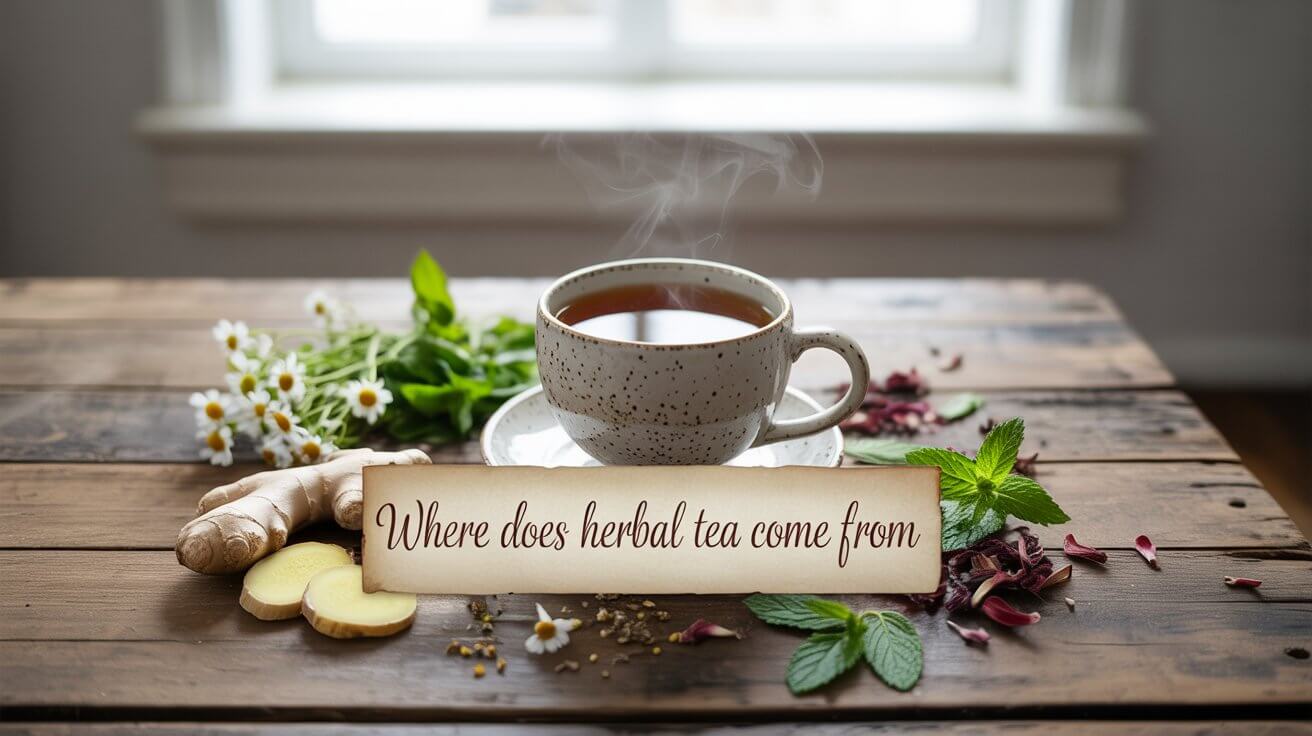Herbal tea isn’t just a beverage, it’s a bridge between nature, culture, and wellness traditions that span thousands of years. From the temples of ancient Egypt to modern wellness cafés, herbal tea has evolved into one of the world’s most cherished caffeine-free drinks. But where does herbal tea really come from, and why does it remain such an essential part of global health culture in 2025?
Let’s explore the origins, ingredients, and cultural significance that make herbal tea a timeless favorite for relaxation, hydration, and healing.
What Is Herbal Tea? (Nature’s Infusion of Wellness)
Unlike black, green, or oolong tea, which all come from the Camellia sinensis plant, herbal tea also known as a tisane is made by steeping various herbs, flowers, roots, seeds, and spices in hot water.
Because it’s typically caffeine-free, herbal tea is a calming and hydrating choice for any time of day.
Common Herbal Teas and Their Natural Origins
-
Chamomile – Europe and the Mediterranean (used for relaxation and sleep)
-
Peppermint – Native to Asia and Europe (great for digestion)
-
Hibiscus – Africa and the Caribbean (rich in antioxidants, tart and refreshing)
-
Ginger – Southeast Asia (warming and soothing for the stomach)
-
Rooibos – South Africa (naturally sweet, rich in minerals)
-
Lavender – France and the Mediterranean (known for stress relief and aroma therapy)
Visual Tip: Add an infographic showing a world map highlighting where each herb originates this visual helps readers connect herbal tea to its cultural roots.
The Historical Origins of Herbal Tea
Herbal tea’s history stretches back over 5,000 years, and nearly every civilization developed its own version of herbal infusions for healing, ceremony, and comfort.
Ancient Egypt (Around 1550 BC)
Egyptians brewed chamomile and hibiscus teas for healing and relaxation even using them in burial rituals for their symbolic purity.
China
In Traditional Chinese Medicine (TCM), herbs like ginger, ginseng, and chrysanthemum were steeped to balance energy (Qi) and restore health. Herbal tea remains integral to Chinese wellness today.
Greece and Rome
Philosophers and healers like Hippocrates promoted mint and sage teas for digestion and vitality marking one of the earliest links between herbal tea and preventive health.
Indigenous Cultures
Native communities in North and South America brewed herbal teas from local roots, leaves, and berries not only for physical healing but also for spiritual balance.
Expert Insight (2025 View):
Today’s global herbal tea market still draws inspiration from these ancient traditions but with a modern twist: sustainability, organic sourcing, and science-backed blends are driving the new tea renaissance.
Where Do Herbal Tea Ingredients Come From?
Herbal teas are globally diverse because their ingredients come from many different plants and regions unlike green or black tea, which all trace back to one species.
| Ingredient Type | Examples | Common Origins |
|---|---|---|
| Leaves | Peppermint, lemongrass, sage | Europe, Asia |
| Flowers | Chamomile, hibiscus, lavender | Egypt, France, Africa |
| Roots | Ginger, turmeric, licorice root | India, China, Southeast Asia |
| Seeds & Spices | Fennel, cinnamon, cardamom | India, Sri Lanka, Middle East |
Different regions are known for their signature herbs:
-
Africa – Rooibos and hibiscus
-
Asia – Ginger, lemongrass, and ginseng
-
South America – Yerba mate and guayusa
-
Europe – Chamomile, mint, and nettle
As of 2025, many tea producers focus on sustainable farming and traceable sourcing, ensuring that herbs are cultivated without synthetic pesticides while preserving local ecosystems.
The Cultural Significance of Herbal Tea
Across the world, herbal tea carries deeper meaning beyond taste or health, it’s woven into rituals, hospitality, and healing traditions.
-
China: Herbal infusions represent harmony and balance in Traditional Chinese Medicine.
-
Middle East: Mint tea is a symbol of friendship and hospitality, often served to guests.
-
Europe: Chamomile tea is a bedtime staple associated with calmness and care.
-
South Africa: Rooibos tea symbolizes community and pride in native traditions.
In each culture, herbal tea serves as both medicine and connection a shared ritual that reflects gratitude, comfort, and mindfulness.
Modern Popularity of Herbal Tea (2025 Trends)
In today’s fast-paced world, herbal tea has become a wellness essential. Health-conscious consumers now look for functional teas those that support energy, digestion, detoxification, or sleep.
Popular trends include:
-
Adaptogenic Blends: Featuring herbs like ashwagandha and tulsi for stress relief.
-
Slimming Teas: Herbal blends that support metabolism without harsh diuretic effects.
-
Caffeine-Free Detox Teas: Ideal for hydration and gentle cleansing.
One example is the All Day Slimming Tea, which combines herbs and green tea extracts to promote digestion, metabolism, and steady energy making it a great modern evolution of traditional herbal infusions.
You can explore more about such wellness blends on alldayslimmingtea.blog.
Expert Comment: “The herbal tea trend isn’t just about flavor it’s about functionality. Consumers in 2025 are choosing teas that work in sync with their lifestyle and health goals.”
Why Herbal Tea Is Here to Stay
From ancient Egypt’s hibiscus brews to modern-day detox blends, herbal tea’s journey shows that it’s more than a drink, it’s a ritual rooted in balance, nature, and culture.
Its flexibility means there’s a cup for everyone:
-
Chamomile for calm
-
Peppermint for digestion
-
Ginger for warmth
-
Rooibos for mineral-rich hydration
Whether you’re seeking better sleep, digestive comfort, or mindful relaxation, herbal tea continues to connect people across continents and centuries.
Conclusion
So, where does herbal tea come from?
It comes from nature herbs, roots, flowers, and spices and from the heart of cultures that have used these plants for wellness and connection for thousands of years.
As of 2025, herbal tea remains one of the most diverse, sustainable, and health-centered drinks in the world. Every cup tells a story one of tradition, discovery, and the timeless quest for balance.


Leave a Reply